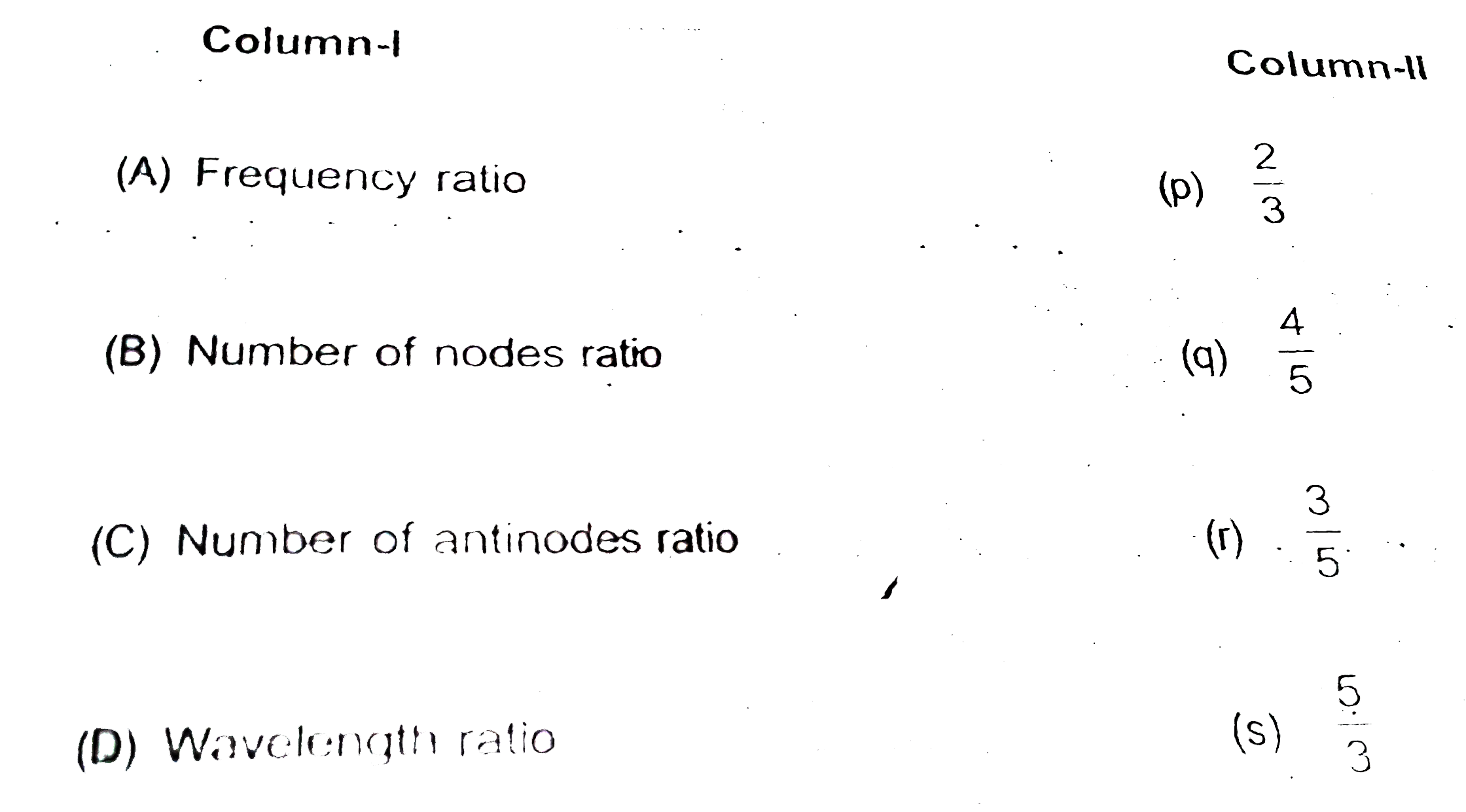Transverse waves are produced in a stretched wire. Both ends of the string are fixed. Let us compare between second overtone mode (in numerator) and fifth harmonic, mode (in denominator).
match the following column-I with column-II

The correct Answer is:A, B, C, D
Step by step video & image solution for Transverse waves are produced in a stretched wire. Both ends of the string are fixed. Let us compare between second overtone mode (in numerator) and fifth harmonic, mode (in denominator). match the following column-I with column-II by Physics experts to help you in doubts & scoring excellent marks in Class 12 exams.
Updated on:21/07/2023Topper's Solved these Questions
- WAVESBook:AAKASH INSTITUTEChapter:WAVESExercise:Assignment (Section-G) (Integer Type)
Explore 4 Videos
- WAVESBook:AAKASH INSTITUTEChapter:WAVESExercise:Assignment (Section-H) (Mutiple true-false type questions)
Explore 3 Videos
- WAVESBook:AAKASH INSTITUTEChapter:WAVESExercise:Assignment (Section-E) Assertion & Reason
Explore 13 Videos
- WAVE OPTICSBook:AAKASH INSTITUTEChapter:WAVE OPTICSExercise:Assignment (Section-J (Aakash Challengers question))
Explore 1 Video
- WORK, ENERGY AND POWERBook:AAKASH INSTITUTEChapter:WORK, ENERGY AND POWERExercise:Assignment (SECTION - D)
Explore 15 Videos
Similar Questions
A string fixed at both ends first oscillates in its fundamental mode then in second harmonic mode.Then match the following.

View SolutionA transverse wave is produced on a stretched string 0.9 m long and fixed at its ends. Find the speed of the transverse wave, when the string vibrates while emitting second overtone of frequency 324 Hz.
View Solution
Knowledge Check
A wire is stretched and fixed at two ends. Transverse stationary waves are formed in it. It oscillates in its third overtone mode. The equation of stationary wave is
y=Asinkxcosωt
Choose the correct options.AAmplitude of constituent waves is A2BThe wire oscillates in three loopsCThe length of the wire is 4πkDSpeed of stationary wave is ωkStationary waves are produced in a length of wire fixed between two points . Compare the amplitudes at an antinode for the fundamental and the first overtone . Assume that the total energy of the initial waves is, on an average, equally divided between the two modes.
A3√2B1√2C12D12√2Assertion: A wire is stretched and then fixed at two ends. It oscillates in its second overtone mode. There are total four nodes and three antinodes.
Reason: In second overtone mode, length of wire should be l=3λ2, where λ is wavelength.AIf both Assertion and Reason are true and the Reason is correct explanation of the Assertion.BIf both Assertion and Reason are true but Reason is not the correct explanation of Assertion.CIf Assertion is true, but the Reason is false.DIf Assertion is false but the Reason is true.
The fundamental frequency of air column in a pipe open a both ends is 200 Hz. What is the frequency of the (i) second harmonic (ii) third overtone ?
View SolutionStationary wave of frequency 5 K Hz is produced in a tube open at both ends and filled with air at 300K. The tube is oscillating in its first overtone mode.
(a) Find the length of the tube assuming that air contains only nitrogen and oxygen in molar ratio of 3:1.
(b) What shall be the frequency of sound wave used so that the same tube oscillates in its second overtone mode?
View SolutionConsider a uniform wire of length l. Cross-sectional area A, Young's modulus of the material of the wave is Y. Some information related to the wire is given in column-1 and dependence of the result is given in column-2. Then match the approprite choice between the columns and match the list given in options
Column-I Column-II(A) Let us suspend wire vertically from a (p) Young'sModulusrigud support and attach a mass m atits lower end. If the mass is slightly pulleddown and released, it executes S.H.Mof a time period which will depend on(B) Work done in stretching the wire up to length (q) elongation (x)l+xwill depend on(C) If the given is fixed between two rigid (r) length (l)supports and its temperature is decreasedthermal stress that develops in the wirewill depend on(D) If the wire is pulled at its ends equal and (s) area of cross-section (A) opposite forces of magnitude F so that itundergoes an elongation x, according toHook's law, F=kx, where k is the forceconstant.Force constant (k) of the wirewill depend on
View SolutionA stretched wire is oscillating in third overtone mode. Equation of transverse stationary wave produced in this wire is
y=Asin(6πx)sin(20πt)
Here, x is in metres. Find the length of the wire.
View SolutionThe frequency of fundamental mode of vibration of a stretched string fixed at both the ends is 25 Hz. If the string is made to vibrate with 7 nodes , what is the frequency of vibration ? If the length of string is 3 m , what is the frequency of the 4th harmonic ?
View Solution

